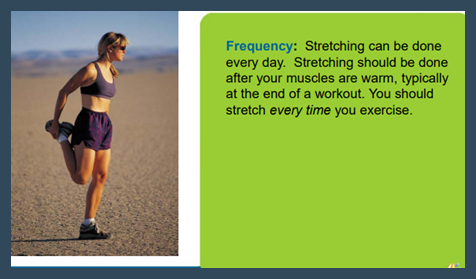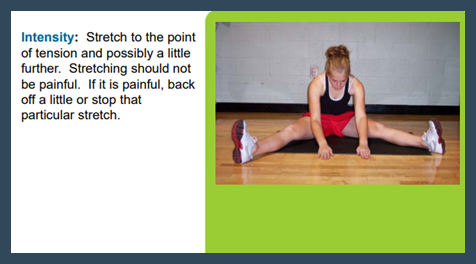Fitness Principles
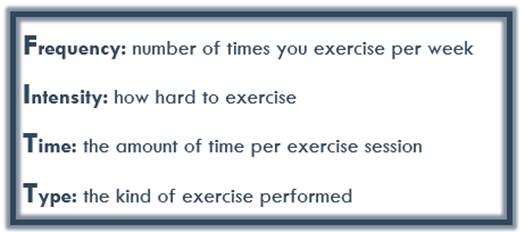
Key Vocabulary
Section A: Fitness Components
There are three primary levels of physical activities
based on the intensity of the activity:
1. Lifestyle Physical
Activity:
these are life activities such as working in the garden or slow walking
a.
The benefit is a moderate
increase in health and wellness in those who are entirely sedentary; reduced
risk of some chronic diseases

2. Moderate Physical
Activity: light to moderate exercise such as
recreational and more strenuous yard work
a.
The benefit is increased
cardiorespiratory endurance, lower body fat levels, and improved blood
cholesterol; increased overall physical fitness

3. Vigorous Physical
Activity: moderate to strenuous exercises such as
traditional exercise classes and sports
a.
The benefit is the overall
physical fitness, decreased risk of disease, further improvements in overall
strength and endurance
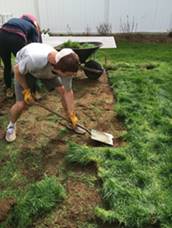
The Health Components of Fitness are listed
below:
1. Aerobic endurance: To exercise the heart to provide the muscles with the oxygen
they need
2. Muscular strength: To use a muscle to produce enough force to move an object a
few times
3. Muscular endurance: to use a muscle many times or for a long period
continuously
4. Flexibility: to be able to move the joints through a large range of motion
5. Body Composition: Describes the percentage of muscle and body fat in the body
Let’s Practice: Drag and Drop
The Skill Components of Fitness are listed
below:
1. Agility: The ability to start & stop, change directions, speed up
or slow down
2. Balance: Controlling the body while standing or moving
3. Coordination: To use different parts
of the body together to complete a task
4. Power: The ability to use muscle strength quickly or over a certain
distance
5. Speed: The ability to travel a short distance quickly in a straight
line
6. Reaction Time: The ability to respond to a stimulus quickly and accurately
Let’s Practice: Matching Pairs
Section B: FITT
To see gains
in fitness, the amount of training should exceed what your body is used to
being active. To effectively increase fitness, you must apply an optimal
overload level within a certain period.
You can follow the “10 Percent Rule” by increasing your training
frequency, intensity, or duration by no more than 10% per week. Improvement in a body system will occur only
if that specific system is targeted in training. Training results will vary from person to
person, and overtraining can result in fatigue, soreness, and diminished
training returns.
You must get
physical activity recommendations from reliable sources such as government
agencies and government agencies. Below
are some examples:
·
United States Department of
Health & Human Services
·
President’s Council on
Sports, Fitness & Nutrition
·
Centers for Disease Control
and Prevention
·
United States Department of
Education
Recommendations
from the above sources suggest that “Youth Age” should get 60 minutes of
moderate to vigorous physical activity every day of the week. “Adult Age” should do moderate physical
activity at least 30 minutes per day for at least five days a week.
Below is a
chart called “The Physical Activity Pyramid.”
This is a guide to improve your physical fitness. It recommends different types of activities
you should be doing in a week to stay physically fit. The closer to the pyramid base, the more
frequent the activity.
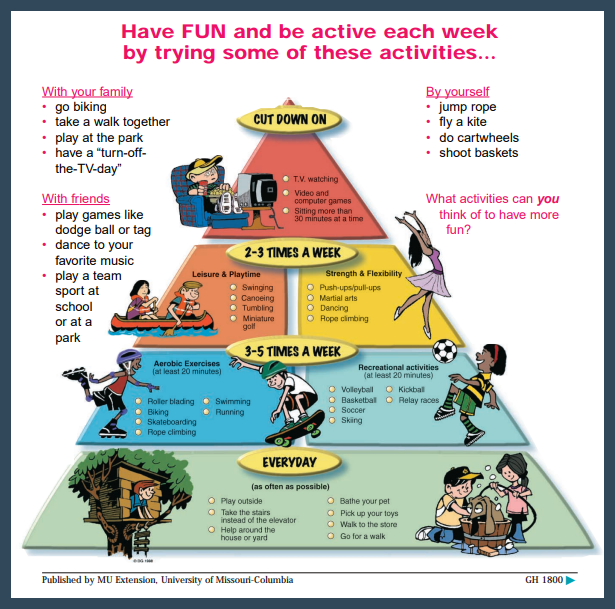
The FITT
principles are an exercise prescription to help participants understand how
long and how hard they should exercise. FITT is an acronym that stands for
Frequency, Intensity, Time, and Type. FITT can be applied to exercise in
general or specific components of exercise.
·
Frequency: number of times you
exercise per week
·
Intensity: how hard to exercise
·
Time: the amount of time per
exercise session
·
Type: the kind of exercise
performed
|
FITT |
Aerobic |
Muscular Strength |
Muscular Endurance |
Flexibility |
Body Composition |
|
Frequency |
3-5 times per week |
2-3 days per week |
Alternate days three times per week |
Daily |
5 to 7 times per week |
|
Intensity |
60-85% max heart rate |
60-85% max strength |
Low to moderate resistance |
To the point of mild discomfort |
Combination of intensities |
|
Time |
20-30 minutes |
20-30 minutes |
3 sets of 10 to 20 repetitions |
15-30 minutes |
Dependent on intensity |
|
Type |
Treadmill |
Bench Press |
Free weights |
Leg and arm stretches |
Aerobic, anaerobic, resistance |
Let’s Practice: Video Challenge
Unit Activity Log
Throughout this course, you will be given more examples of
warm-ups, exercise activities, and cooldowns.
If you have any questions or concerns at any time, please message your
teacher. Below is an activity applying
the FITT Principles provided by “Carone Fitness” that
you can utilize to complete your "Unit Activity Logs."
|
Applying
the FITT Principles Flexibility |
|
|
|
|
|
|
|
|
